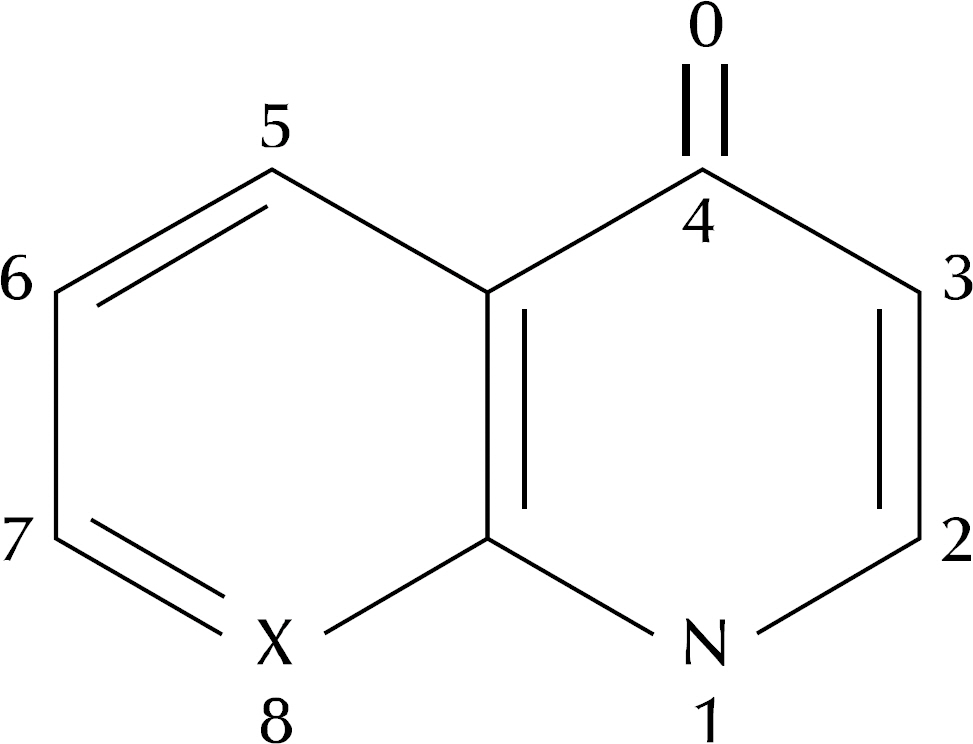Korean J Urogenit Tract Infect Inflamm.
2015 Apr;10(1):1-6. 10.14777/kjutii.2015.10.1.1.
Current Updates in Pharmacokinetics and Pharmacodynamics of Fluoroquinolones
- Affiliations
-
- 1Department of Urology, Yeungnam University College of Medicine, Daegu, Korea. sph04@hanmail.net
- KMID: 1839381
- DOI: http://doi.org/10.14777/kjutii.2015.10.1.1
Abstract
- The ultimate goal of antimicrobial treatment is to decrease the morbidity and mortality related to infection. Maximizing these outcomes requires an understanding of the complex interactions between the drug administered, the host, and the infecting pathogen. Pharmacokinetics, which deals with the disposition of a drug in the body, focuses on such parameters as absorption, distribution, and elimination. Pharmacodynamics more specifically focuses on the interaction between the drug concentration at the site of action over time and the resulting antimicrobial effect. Use of quinolones has increased in vitro activity against several important pathogenic organisms as well as augmented pharmacokinetic parameters. These properties result in enhanced pharmacodynamic characteristics and should improve therapeutic outcomes against selected pathogens. In this article the pharmacokinetics and pharmacodynamic potential of these quinolones, particularly fluoroquinolones, is reviewed.
Keyword
MeSH Terms
Figure
Reference
-
1. Craig WA. Pharmacokinetic/pharmacodynamic parameters: rationale for antibacterial dosing of mice and men. Clin Infect Dis. 1998; 26:1–10.2. Mueller M, de la Peña A, Derendorf H. Issues in pharmacokinetics and pharmacodynamics of anti-infective agents: kill curves versus MIC. Antimicrob Agents Chemother. 2004; 48:369–77.
Article3. Andriole VT. The quinolones: past, present, and future. Clin Infect Dis. 2005; 41(Suppl 2):S113–9.
Article4. Ball P. Adverse drug reactions: implications for the development of fluoroquinolones. J Antimicrob Chemother. 2003; 51(Suppl 1):21–7.
Article5. Jacoby GA. Mechanisms of resistance to quinolones. Clin Infect Dis. 2005; 41(Suppl 2):S120–6.
Article6. O'Donnell JA, Gelone SP. The newer fluoroquinolones. Infect Dis Clin North Am. 2004; 18:691–716.7. Mehlhorn AJ, Brown DA. Safety concerns with fluoroquinolones. Ann Pharmacother. 2007; 41:1859–66.
Article8. Montay G, Bruno R, Vergniol JC, Ebmeier M, Le Roux Y, Guimart C, et al. Pharmacokinetics of sparfloxacin in humans after single oral administration at doses of 200, 400, 600, and 800 mg. J Clin Pharmacol. 1994; 34:1071–6.
Article9. Davis R, Bryson HM. Levofloxacin. A review of its antibacterial activity, pharmacokinetics and therapeutic efficacy. Drugs. 1994; 47:677–700.10. Nakashima M, Uematsu T, Kosuge K, Umemura K, Hakusui H, Tanaka M. Pharmacokinetics and tolerance of DU-6859a, a new fluoroquinolone, after single and multiple oral doses in healthy volunteers. Antimicrob Agents Chemother. 1995; 39:170–4.
Article11. Cohen KA, Lautenbach E, Weiner MG, Synnestvedt M, Gasink LB. Coadministration of oral levofloxacin with agents that impair absorption: impact on antibiotic resistance. Infect Control Hosp Epidemiol. 2008; 29:975–7.
Article12. Barton TD, Fishman NO, Weiner MG, LaRosa LA, Lautenbach E. High rate of coadministration of di- or tri-valent cation-containing compounds with oral fluoroquinolones: risk factors and potential implications. Infect Control Hosp Epidemiol. 2005; 26:93–9.
Article13. Teng R, Harris SC, Nix DE, Schentag JJ, Foulds G, Liston TE. Pharmacokinetics and safety of trovafloxacin (CP-99,219), a new quinolone antibiotic, following administration of single oral doses to healthy male volunteers. J Antimicrob Chemother. 1995; 36:385–94.14. Child J, Andrews JM, Wise R. Pharmacokinetics and tissue penetration of the new fluoroquinolone grepafloxacin. Anti-microb Agents Chemother. 1995; 39:513–5.
Article15. Johnson JH, Cooper MA, Andrews JM, Wise R. Pharmacokinetics and inflammatory fluid penetration of sparfloxacin. Antimicrob Agents Chemother. 1992; 36:2444–6.
Article16. Child J, Mortiboy D, Andrews JM, Chow AT, Wise R. Open-label crossover study to determine pharmacokinetics and penetration of two dose regimens of levofloxacin into inflammatory fluid. Antimicrob Agents Chemother. 1995; 39:2749–51.
Article17. Tanimura H, Uchiyama K, Kashiwagi H. Gallbladder tissue concentrations, biliary excretion and pharmacokinetics of OPC-17116. Drugs. 1995; 49(Suppl 2):341–3.
Article18. Matsuda S. Clinical experience with OPC-17116 in the treatment of gynaecological infections and its penetration into gynaecological tissues. Japanese Collaborative Study Group of OPC-17116 in Gynaecology. Drugs. 1995; 49(Suppl 2):395–8.19. Borner K, Borner E, Lode H. A metabolite of sparfloxacin in urine. Drugs. 1993; 45(Suppl 3):S303–4.
Article20. Radandt JM, Marchbanks CR, Dudley MN. Interactions of fluoroquinolones with other drugs: mechanisms, variability, clinical significance, and management. Clin Infect Dis. 1992; 14:272–84.
Article21. Tanaka M, Kurata T, Fujisawa C, Ohshima Y, Aoki H, Okazaki O, et al. Mechanistic study of inhibition of levofloxacin absorption by aluminum hydroxide. Antimicrob Agents Chemother. 1993; 37:2173–8.
Article22. Shiba K, Sakamoto M, Nakazawa Y, Sakai O. Effects of antacid on absorption and excretion of new quinolones. Drugs. 1995; 49(Suppl 2):360–1.
Article23. Flor S, Guay DR, Opsahl JA, Tack K, Matzke GR. Effects of magnesium-aluminum hydroxide and calcium carbonate antacids on bioavailability of ofloxacin. Antimicrob Agents Chemother. 1990; 34:2436–8.
Article24. Johnson RD, Wilson J, Dorr MB, Jensen BK, Talbot GH, Heald DL. The effect of sparfioxacin on the pharmacokinetics of theophylline at steady-state conditions. J Clin Pharmacol. 1995; 35:936.25. Wispelwey B. Clinical implications of pharmacokinetics and pharmacodynamics of fluoroquinolones. Clin Infect Dis. 2005; 41(Suppl 2):S127–35.
Article26. Grant EM, Kuti JL, Nicolau DP, Nightingale C, Quintiliani R. Clinical efficacy and pharmacoeconomics of a continuous-infusion piperacillin-tazobactam program in a large community teaching hospital. Pharmacotherapy. 2002; 22:471–83.
Article27. Dandekar PK, Maglio D, Sutherland CA, Nightingale CH, Nicolau DP. Pharmacokinetics of meropenem 0.5 and 2 g every 8 hours as a 3-hour infusion. Pharmacotherapy. 2003; 23:988–91.
Article28. Ambrose PG, Bhavnani SM, Owens RC Jr. Clinical pharmacodynamics of quinolones. Infect Dis Clin North Am. 2003; 17:529–43.
Article29. Quintiliani R. Using pharmacodynamic and pharmacokinetic concepts to optimize treatment of infectious diseases. Infect Med. 2004; 21:219–32.30. Stein GE. Pharmacokinetics and pharmacodynamics of newer fluoroquinolones. Clin Infect Dis. 1996; 23(Suppl 1):S19–24.
Article31. MacGowan AP, Rogers CA, Holt HA, Wootton M, Bowker KE. Pharmacodynamics of gemifloxacin against Streptococcus pneumoniae in an in vitro pharmacokinetic model of infection. Antimicrob Agents Chemother. 2001; 45:2916–21.
- Full Text Links
- Actions
-
Cited
- CITED
-
- Close
- Share
- Similar articles
-
- Pharmacokinetics and pharmacodynamics of drugs for sedation
- How to design intravenous anesthetic dose regimens based on pharmacokinetics and pharmacodynamics principles
- Pharmacokinetics and Pharmacodynamics of Antibiotics : General Concepts and Recent Advances
- Antibiotic Therapy for Pediatric Patients
- Anaphylactoid reaction to ofloxacin with cross-reactivity to other fluoroquinolones


